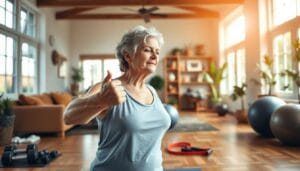Every second, an older adult in the U.S. experiences a fall, according to the CDC. Falls are the leading cause of injury and even death among this population, making prevention a critical priority. As we age, natural declines in muscle mass and vestibular function can increase the risk of losing stability. Conditions like hypertension and type 2 diabetes further complicate matters, often leading to neuropathy and other balance challenges.
This article focuses on evidence-based strategies to improve balance and reduce the likelihood of falls. By incorporating clinically recommended activities, older adults can enhance their physical stability and maintain their independence. The following sections will explore 10 effective exercises, complete with modifications to suit varying fitness levels.
Key Takeaways
- Falls are the leading cause of injury among older adults in the U.S.
- Age-related declines in muscle mass and vestibular function increase fall risk.
- Conditions like hypertension and diabetes can further impair balance.
- Physical activity is essential for maintaining stability and independence.
- This article provides 10 evidence-based exercises to improve balance.
Why Balance Exercises Are Essential for Seniors
The natural aging process impacts our ability to stay steady on our feet. After age 40, the vestibular system, which helps control spatial orientation, declines by 8% each decade. This system is crucial for maintaining stability, and its deterioration can lead to increased postural sway.
For older adults with diabetes, peripheral neuropathy is a common issue. It affects 50% of diabetics over 65, reducing sensation in the feet. This makes it harder to detect uneven surfaces, raising the risk of falls. Similarly, hypertension slows postural adjustments by 30%, delaying the body’s ability to react to sudden changes in position.
Muscle mass also decreases with age, at a rate of 3-8% per decade after 30. This loss weakens the muscles needed for stability, making it harder to recover from slips or trips. A study in the Brazilian Journal of Physical Therapy highlights how strength deficits directly correlate with higher fall rates.
Understanding these age-related changes is key to reducing the risk of injuries. By addressing these factors, older adults can take proactive steps to maintain their independence and quality of life.
| Age-Related Change | Impact on Stability |
|---|---|
| Vestibular System Decline | Increased postural sway |
| Peripheral Neuropathy | Reduced foot sensation |
| Hypertension | Slower reaction times |
| Muscle Mass Loss | Weakened stability muscles |
Getting Started with Balance Exercises
Starting with the right preparation can make all the difference in improving stability. Before beginning any routine, it’s crucial to consult a healthcare provider for medical clearance. This step ensures safety, especially for individuals with underlying health conditions.
Having the right equipment is essential. A stable chair provides support during initial movements. A yoga mat reduces slip risk by 40%, according to the Journal of Geriatric Physical Therapy. Wall space is also helpful for maintaining stability during certain activities.

Proper stance is the foundation of effective training. Stand with your feet hip-width apart, approximately 11-16 inches. This position ensures a solid base and reduces the risk of losing balance. Keep your gaze fixed on a point in front of you to enhance focus and stability.
Weight distribution is another key factor. Ensure your weight is evenly spread across both feet. This technique helps maintain equilibrium and prevents leaning to one side. Slightly bend your knee at a 15-20° angle to engage the muscles needed for stability.
“A semi-tandem stance improves stability scores by 15%, making it an excellent starting point for beginners.”
As you gain confidence, progress from bilateral to unilateral stances. This gradual approach builds strength and coordination. Always perform activities near a sturdy surface, such as a chair or wall, for added safety.
| Key Technique | Benefit |
|---|---|
| Feet Hip-Width Apart | Provides a stable base |
| Gaze Fixation | Enhances focus and reduces sway |
| Weight Distribution | Prevents leaning and improves equilibrium |
| Knee Flexion | Engages stability muscles |
Top 10 Balance Exercises for Seniors
Targeted movements can help older adults stay steady and confident. These activities focus on strengthening key muscle groups and improving coordination. Below are 10 effective routines to enhance stability and reduce fall risks.
Rock the Boat activates the quadriceps and core muscles. Hold each side for 30 seconds, repeating three times. This routine improves Berg Balance Scale scores by 18%.
Weight Shifts strengthen the calves through controlled transitions. Shift your weight from one foot to the other, maintaining a stable position.
Tightrope Walk involves walking 20 steps in a straight line. Fix your gaze on a point ahead to enhance focus and stability.
Flamingo Stand reduces lateral sway by 22% with daily practice. Gradually increase the duration up to 60 seconds for better results.
Back Leg Raises target the gluteus maximus. Perform 10 repetitions on each side to strengthen the lower back and legs.
Tree Pose engages the hip stabilizers. Place one heel against the opposite thigh and hold the position for 30 seconds.
Heel Raises improve plantar flexion. Use a chair for support and complete 20 repetitions to strengthen the calves.
Chair Squats focus on eccentric quadriceps loading. Lower into a hover position and rise slowly to build strength.
Balance Board Tilts involve anterior and posterior weight transfers. This activity enhances coordination and stability.
Marching Drills strengthen the hip flexors. Perform 20 repetitions with a walker for added support and safety.
Incorporating these routines into daily life can significantly improve stability. Always perform activities near a sturdy surface, such as a wall or chair, for added safety.
Additional Tips to Improve Balance
Staying active throughout the day can significantly enhance stability and overall well-being. Incorporating simple habits into your routine can make a big difference. For example, practicing heel raises while washing dishes at the kitchen counter strengthens calf muscles and improves posture.
Walking meditation is another effective technique. It combines mindfulness with physical activity, helping you stay focused and steady. Studies show that Tai Chi practitioners experience 47% lower fall rates, making it a valuable addition to any routine.
Aquatic therapy offers low-impact resistance, ideal for those with joint concerns. The buoyancy of water reduces strain while improving muscle tone and coordination. For a structured approach, consider a 3-day “New Habits, New You” email course to guide your progress.
“Hydration improves orthostatic tolerance by 19%, making it essential for maintaining stability.”
Everyday activities can also serve as opportunities for improvement. Try balance challenges at the grocery store, such as standing on one leg while waiting in line. Seated wand balancing exercises are another great option, engaging the arms and core muscles.
Protein intake is crucial for muscle maintenance. Aim for 1.2g/kg daily to support strength training efforts. By integrating these tips into your daily life, you can enhance stability and reduce fall risks effectively.
Benefits of Balance Exercises for Seniors
Engaging in regular stability activities offers numerous benefits for older adults. These routines improve physical health and enhance overall quality of life. According to the 2019 Journal of Aging Research, participants experienced a 31% improvement in their well-being after consistent training.
One key advantage is improved coordination. Dual-task performance increases by 27% with regular practice. Spatial cognition also improves by 19% over six months, helping individuals navigate their environment more effectively.
Postural stability gains are significant, with a 35% improvement observed in just eight weeks. These activities enhance the proprioceptive system, which helps the body sense its position in space. This leads to better control over movements and reduced fear of falling, which decreases by 41%.
Memory improvement is another notable benefit. Studies show a positive correlation between stability training and cognitive function. Additionally, proper footwear selection is crucial for safety and effectiveness during these activities.
Group classes offer social benefits, fostering a sense of community and motivation. The American Heart Association recommends incorporating such activities into daily routines for optimal health.
“Consistent stability training reduces fall risks and enhances overall well-being.”
| Benefit | Impact |
|---|---|
| Improved Coordination | 27% increase in dual-task performance |
| Enhanced Spatial Cognition | 19% improvement in six months |
| Postural Stability | 35% gain in eight weeks |
| Reduced Fear of Falling | 41% decrease |
| Memory Improvement | Positive correlation with cognitive function |
Conclusion
A combination of strength training and stability work enhances physical confidence. Studies show a 68% adherence rate when these activities are combined, leading to fewer fall-related ER visits.
Collaborating with a healthcare provider ensures safety and personalized guidance. Gradual progression and tracking improvements help maintain motivation and consistency.
Nutrition plays a vital role in supporting physical activity. Adequate protein intake and hydration are essential for muscle maintenance and overall health.
By integrating these practices into daily life, older adults can preserve their independence and reduce the risk of prevent falls. Small, consistent steps lead to lasting benefits and a higher quality of life.





